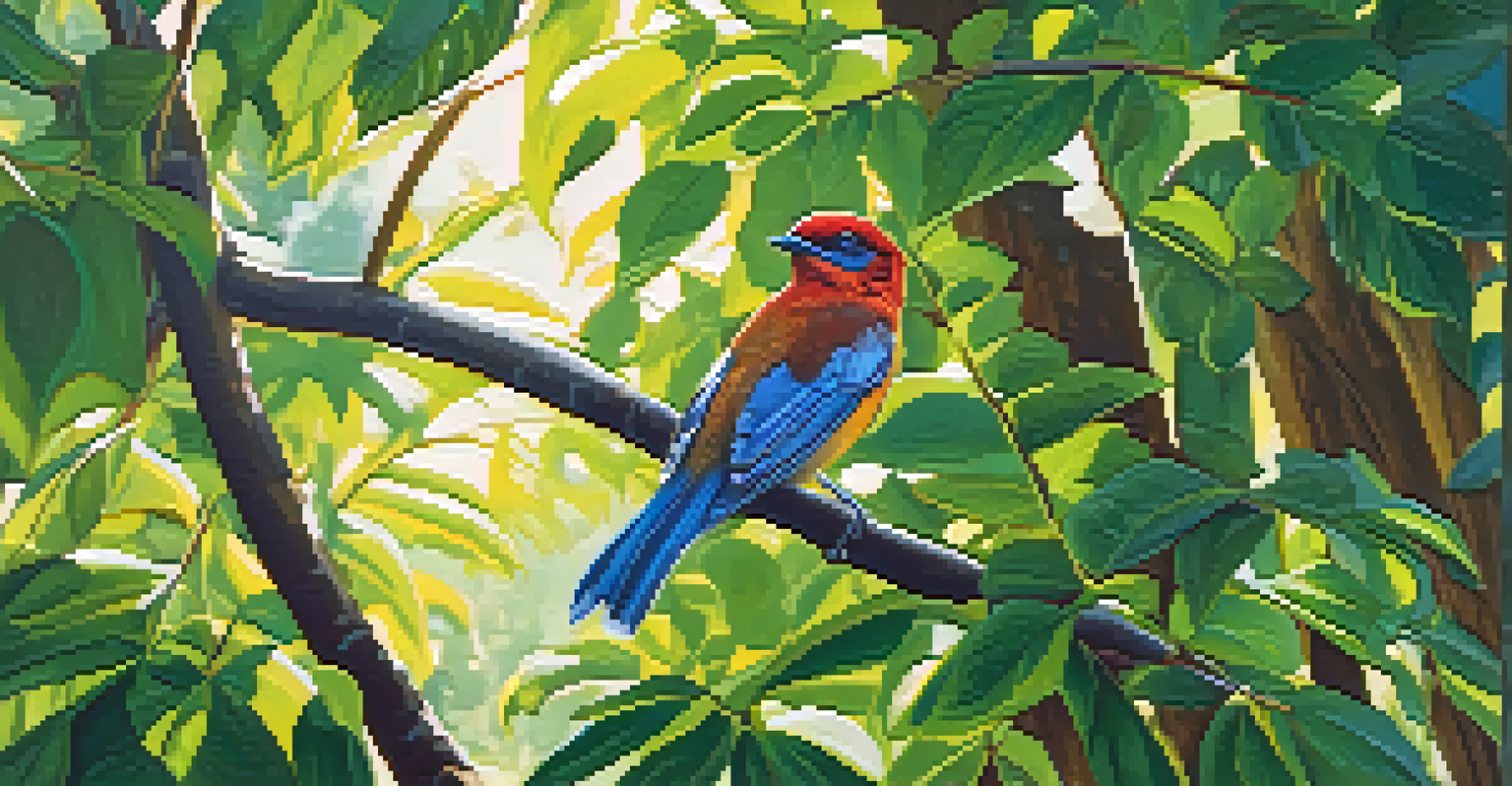Safety Tips for Wildlife Watching in Big Bear Area

Understand Local Wildlife and Their Habitats
Before heading out, it’s important to familiarize yourself with the types of wildlife you might encounter in the Big Bear area. From black bears to deer and various bird species, each has unique behaviors and habitats. Understanding these animals helps you recognize their signs and movements, making your wildlife watching experience both educational and safe.
In every walk with nature one receives far more than he seeks.
For instance, knowing that bears are often active during dawn and dusk can help you plan your outings for safer encounters. Moreover, being aware of their typical feeding grounds, like berry bushes or streams, can lead to more rewarding sightings. Remember, this knowledge not only enhances your experience but also helps you to respect their space and avoid startling them.
Lastly, consider carrying a local wildlife guidebook or using a wildlife identification app. These resources can provide valuable insights into the animals you might see, their behaviors, and tips on how to observe them responsibly. The more informed you are, the more enjoyable and safe your wildlife adventure will be.
Keep a Safe Distance from Wildlife
One of the most crucial safety tips when wildlife watching is to maintain a safe distance from the animals. Approaching too closely can stress the animals and may provoke defensive behaviors. A good rule of thumb is to stay at least 100 yards away from large animals like bears and moose, while smaller creatures like rabbits and birds should also be observed from a respectful distance.

Using binoculars or a zoom lens on your camera can help you enjoy close-up views without intruding on their space. This not only respects the wildlife but also allows you to capture stunning photos without the risk of getting too close. Remember, wildlife is unpredictable; what seems like a calm animal can become agitated if it feels threatened.
Know Local Wildlife and Habitats
Familiarizing yourself with local wildlife behaviors and habitats enhances your observation experience and promotes safety.
Additionally, if you find yourself in a situation where an animal approaches you, remain calm and back away slowly. Sudden movements can startle them, leading to harmful outcomes for both you and the animal. Staying aware of your surroundings and respecting the natural boundaries of wildlife is key to a safe experience.
Be Mindful of the Environment
When you're in the great outdoors, it's essential to tread lightly and respect the environment. This means sticking to marked trails and avoiding trampling vegetation, which can disturb local wildlife habitats. By staying on designated paths, you help preserve the ecosystem and ensure that animals have a safe space to thrive.
The earth has music for those who listen.
Additionally, be mindful of noise levels. Loud noises can scare animals away or lead them to act unpredictably. A peaceful environment allows for better wildlife watching experiences and helps maintain the natural beauty of the area. Think of it as being a guest in their home; the quieter and more respectful you are, the more likely you are to be welcomed.
Lastly, always pack out what you pack in. Litter can be harmful to wildlife and disrupt their natural behaviors. Carry a small trash bag with you to ensure that you leave the beautiful Big Bear area just as you found it, keeping it safe for future visitors and the wildlife that calls it home.
Know the Rules and Regulations
Before heading out for wildlife watching, familiarize yourself with local rules and regulations regarding wildlife interactions. Many parks and natural areas have specific guidelines designed to protect both visitors and wildlife. These regulations can include restrictions on feeding animals, which is crucial for their health and safety.
For instance, feeding wildlife can lead animals to become reliant on humans for food, altering their natural behaviors and putting them at risk. Additionally, some areas may have designated viewpoints or restrictions on certain trails to minimize human impact on sensitive habitats. By adhering to these rules, you help ensure a sustainable environment for all.
Maintain a Safe Distance
Keeping a respectful distance from wildlife ensures both your safety and the well-being of the animals.
Check with local wildlife agencies or park websites for any updates or changes to regulations before your visit. This not only helps you stay informed but also enhances your wildlife watching experience by ensuring you're following best practices. Being a responsible observer contributes to the safety of both yourself and the wildlife you admire.
Dress Appropriately for Wildlife Watching
Dressing appropriately for your wildlife watching adventure is key to both comfort and safety. The weather in Big Bear can change quickly, so layering is a smart choice. Start with moisture-wicking base layers, add an insulating layer, and finish with a waterproof outer layer to ensure you stay warm and dry.
Footwear is just as important; sturdy, comfortable hiking boots can protect your feet and provide good traction on various terrains. Don't forget to consider accessories like hats, sunglasses, and sunscreen, which help protect you from the sun’s rays, especially if you'll be out for several hours. Being comfortable allows you to focus on the wildlife instead of your discomfort.
Lastly, consider bringing a small backpack to carry essentials like water, snacks, and a first-aid kit. Staying hydrated and nourished is vital for maintaining your energy levels during long outings. When you're well-prepared, you can fully enjoy the wonders of wildlife watching without unnecessary distractions.
Bring Binoculars and Cameras for Observing Wildlife
Equipping yourself with binoculars and a good camera can significantly enhance your wildlife watching experience. Binoculars allow you to observe animals from a safe distance, giving you the chance to see their details without intruding on their space. This means you can enjoy their natural behaviors while minimizing stress on the animals.
A camera, especially with a zoom lens, can help capture those magical moments that you can cherish long after your visit. Whether it’s a majestic deer or a colorful bird, having the right equipment allows you to document your adventure. Just remember to respect the wildlife by not getting too close for a better shot.
Dress for Comfort and Safety
Wearing appropriate layers and sturdy footwear prepares you for changing weather and enhances your wildlife watching experience.
When using these tools, practice patience. Wildlife doesn’t always perform on cue, and sometimes you’ll need to wait for the right moment. This patience not only leads to better observations but also mirrors the calmness and respect needed when interacting with nature. Ultimately, your experiences will be richer, and your memories will last longer.
Stay Alert and Aware of Your Surroundings
Staying alert and aware of your surroundings is crucial while wildlife watching. Animals can appear suddenly, and being attentive can help you avoid unexpected encounters. Keep your eyes peeled and your ears open for sounds that might indicate nearby wildlife, such as rustling leaves or birds calling.
Additionally, be mindful of your own movements. Quiet footsteps and minimized noise can increase your chances of spotting wildlife. If you're with others, maintain a low volume when chatting, as this can help keep the atmosphere calm and allow you to enjoy the sounds of nature.

Finally, it’s wise to stay aware of your personal safety as well. Stay on designated trails and be cautious of your footing, especially in rocky or uneven areas. By remaining vigilant, you can fully immerse yourself in the beauty of Big Bear while ensuring a safe and enjoyable experience.